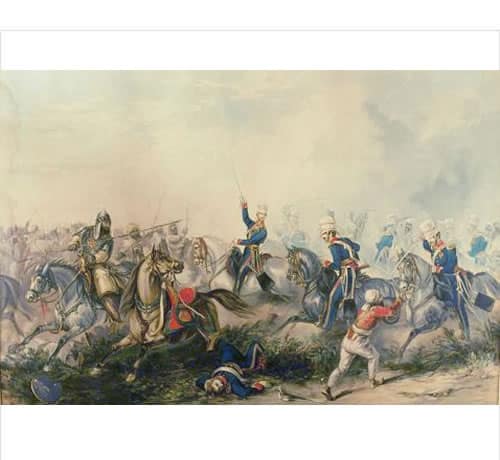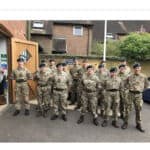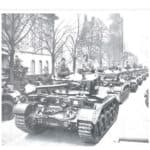Chillianwallah
The Battle of Chillianwala was fought in January 1849 during the Second Anglo-Sikh War in the Chillianwala region of Punjab, now part of modern-day Pakistan. The battle was one of the bloodiest fought by the British East India Company.
The Honour is borne on the Guidon of the 3rd Hussars.
Detail
The two wars fought between 1845 and 1849 between the British and the Sikhs led to the annexation of Punjab by the British East India Company, and one of the most successful military co-operations between two races, stretching into a century of strife on the North-West Frontier of British India, the Indian Mutiny, Egypt and finally the First and Second World Wars’
British troops and Indian troops of the Bengal Presidency fought against Sikhs of the Khalsa, the Army of Punjab.
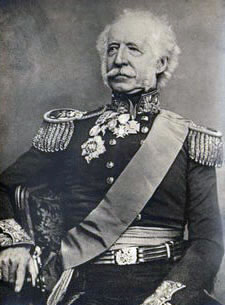
Major General Sir Hugh Gough (left) was the British commander at the Battle of Chillianwallah and the Sikh’s by General Shere Singh.
The British Army numbered 12,000 with 66 guns and the Sikh’s 35,000 with 65 guns.
The British contingent comprised four light cavalry regiments (3rd, 9th, 14th and 16th Light Dragoons, – the 9th and 16th being Lancers) and twelve regiments of foot (9th, 10th, 24th, 29th, 31st, 32nd, 50th, 53rd, 60th, 61st, 62nd and 80th regiments) and Cavalry and Infantry of the Bengal Army
General Gough commanded the British/Indian army at six of the seven major battles (not the Battle of Aliwal). An Irishman, Gough was immensely popular with his soldiers, for whose welfare he was constantly solicitous. The troops admired Gough’s bravery, in action wearing a conspicuous white coat, which he called his ‘Battle Coat’ so that he might draw fire away from his soldiers.
Gough’s tactics were heavily criticised, even in the Indian press in letters written by his own officers. At the Battles of Moodkee, Sobraon and Chillianwallah, Gough launched headlong attacks, considered to be ill-thought out by many of his contemporaries. Casualties were high and excited concern in Britain and India. By contrast, Gough’s final battle, Goojerat, which decisively won the war, cost few of his soldiers their lives and was considered a model of care and planning.
Every battle saw vigorous cavalry actions, with our own 3rd King’s Own Light Dragoons particularly distinguishing themselves.
The weapons for the 3rd King’s Own Light Dragoons cavalry were the sword and carbine.
Commands in the field were given by the cavalry trumpet and the infantry drum and bugle.
In the initial battles, the Sikh artillery outgunned Gough’s batteries. Even in these battles and in the later ones, the Bengal and Bombay horse and field artillery were handled with great resource and were a major cause of Gough’s success.
The Sikhs of the Punjab looked to the sequence of Gurus for their spiritual inspiration and had established their independence, fiercely resisting the Moghul Kings in Delhi and the Muslims of Afghanistan. The Sikhs were required by their religion to wear the ‘five Ks’, not to cut their hair or beard and to wear the highly characteristic turban, a length of cloth in which the hair is wrapped around the head.
The traditional weapon of the Sikh warrior is the ‘Kirpan’, a curved sword kept razor sharp and one of the ‘five Ks’ a baptised Sikh must wear. In battle, at the first opportunity, many of the Sikh foot abandoned their muskets and, joining their mounted comrades, engaged in hand to hand combat with sword and shield. Horrific cutting wounds, severing limbs and heads were a feature of the Sikh Wars, in which neither side gave quarter to the enemy.
Account of the Battle of Chillianwallah.
The Battle of Ramnagar, and General Thackwell’s inconclusive expedition across the Chenab River, had the effect of driving Shere Singh’s Sikh army north from the Chenab, to take up a position against the River Jhelum. On 10th January 1849, the news came to the British commander, Major General Gough, that the Sikh commander, Chattar Singh, had finally captured the fortress of Attock in the extreme northwest corner of the Punjab. It was now a matter of time before Chattar Singh’s force, with its Afghan allies, joined Shere Singh on the Jhelum to create an overwhelming Sikh army.
The Governor-General, Lord Dalhousie, urged General Gough to advance with the British and Bengal ‘Army of the Punjab’ and attack Shere Singh before he could be reinforced. The fall of the city of Multan to its British and Bombay Presidency besiegers released General Whish’s division to re-join the Army of the Punjab, but Dalhousie and Gough took the view that they could not wait for its arrival.
On 13th January 1849, Gough marched up to within eight miles of the Sikh army in its position along the Jhelum River, entrenched in a row of rural hamlets. The Army of the Punjab halted at the village of Chillianwallah and prepared to pitch camp, while Gough carried out reconnaissance.
The Sikh left flank lay on the village of Rasul, in a line of small hills running nearly parallel with the Chenab River. The Sikh right lay against a thick jungle wall. Along the front of the Sikh line was a deep area of scrubby jungle.
The Sikh army comprised 25 infantry battalions, of which 10 had been raised since the end of the First Sikh War, 5,000 Gorcharra irregular cavalry and 65 guns, mostly of a light calibre. It was a feature of the Second Sikh War that the Sikhs had lost the predominance in size and numbers of guns they had possessed in the First Sikh War.
Pitching camp by the Army of the Punjab was interrupted when a battery of Sikh artillery advanced and opened fire on the British and Bengalis until they were forced to retire by the counter-fire of Gough’s artillery. The whole of the Sikh artillery came into action and it became clear that the Sikhs had advanced well forward from their fortified position and that battle was imminent.
Cancelling the order to pitch camp, Gough formed up his regiments and prepared for battle, while his guns returned the Sikh fire.
It is reported that Gough was particularly enraged when several Sikh cannon rounds came the way of his staff. The criticism is made that it would have been better to have acted with restraint and stuck to his plan to give battle the next day.
Gough drew up his infantry in two divisions of two brigades each: from the left; Campbell’s division of Hoggan’s and Pennycuick’s brigades, then Gilbert’s division of Mountain’s and Godby’s brigades. Penny’s brigade provided the infantry reserve. White’s cavalry brigade was posted on the left flank with Pope’s cavalry brigade on the right.
The dense scrub made movement and observation equally difficult and, as always in battles in the Indian plains, the marching of troops and horses and the firing of artillery and infantry weapons created heavy clouds of dust and powder smoke which added to the confusion. Horsford’s heavy guns fired upon the centre of the Sikh position, aided by the field batteries positioned on the flanks of the army. After an hour of bombardment, the infantry was ordered forward to attack.
Campbell’s division on the left, Hoggan’s brigade pushed into the Sikh infantry line and drove it back. Pennycuick’s brigade drifted away to the right, struggling to keep order in the dense scrub. HM 24th Foot, an inexperienced British regiment full of young soldiers, outstripped its two flanking BNI battalions and reached the Sikh lines, attacking and overrunning the Sikh positions, taking many guns.
The Sikhs stormed back into the captured trenches in overwhelming numbers and drove the disordered 24th Foot out in full retreat and with heavy casualties. The two BNI battalions attempted to hold the attack but were forced back, the whole brigade retreating in confusion to its start point.
In the melee, Brigadier Pennycuick, his son, Lieutenant Colonel Brookes, the commanding officer of the 24th, and the two other field officers of the regiment were killed. The 25th and 45th BNI lost all but one of the five colours these two regiments carried. HM 24th Foot lost one colour while the other was rescued by a private soldier. Penny’s brigade advanced into the gap left by the retreat of Pennycuick’s and managed to hold the Sikh pursuit.
Hoggan’s brigade, under General Campbell’s leadership, pushed through the strip of the jungle behind the Sikh lines, supported by the fire of horse and field batteries, coming out on the far side in the presence of a strong force of Sikh infantry, cavalry and guns. 61st Foot charged the body of cavalry and drove them away, while the Sikh infantry repulsed the 36th BNI on their right. 61st wheeled and attacked the Sikh infantry and two guns they had brought up.
On the left of the brigade 46th BNI repulsed a Sikh cavalry charge. The whole brigade formed to its right and advanced down the Sikh line, rolling it up and capturing 13 guns until they joined up with Gilbert’s Division. On the left flank, White’s cavalry brigade found itself confronted by a large force of Sikh Gorcharra irregular horsemen.
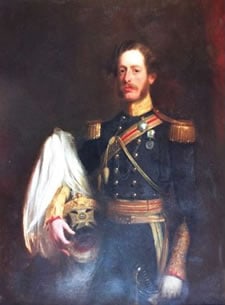
Captain Unett of the 3rdKing’s Own Light Dragoons (left) led his squadron into the charge, galloping as best they could through the broken jungle. General Thackwell, the commander of the cavalry division, ordered the 5th BLC up in support, but the regiment failed to follow Unett’s squadron into the dense mass of Gorcharras.
Unett’s Light Dragoons cut their way through the Sikhs and, turning, charged back, dispersing the threat to the left flank. All the officers of the squadron were wounded.
On the right flank, Pope directed his brigade to advance in line of regiments; two squadrons of 9th Lancers on the right (the remaining two squadrons had been sent away towards the hills), three squadrons of 1st and 6th BLC in the centre and 14th King’s Light Dragoons to their left, with ten guns of Huish’s and Christie’s troops of Bengal Horse Artillery on the extreme left of the brigade. No unit was retained as a supporting line.
Pope led his brigade at the trot through the broken scrub, without the precaution of skirmishers in advance. At the sight of a body of Sikh cavalry, the BLC squadrons in the centre of the line halted, forcing the British regiments on the flanks to stop in conformity. The Sikhs charged the BLC squadrons which turned about and made off. The two British regiments did the same, all attempts by the officers to halt their soldiers being to no avail.
The precipitous withdrawal of the cavalry regiments left the brigade horse artillery battery unprotected, and, in the confusion of limbering up, the battery was overrun by the Sikh cavalry who captured two guns. Eventually, two other guns came into action and were sufficient to drive the Sikh cavalry back.
The retreating cavalrymen from Pope’s brigade found their way back to the camp at Chillianwallah, where they were rounded up by officers of the non-combatant services, including a padre.
The disappearance of the cavalry left Godby’s infantry brigade exposed. The 70th BNI pulled back its right wing to provide cover and, after some hard fighting, the division was able to resume its advance, Mountain’s brigade taking a Sikh battery.
The battle ended with darkness. The Sikh army left the field, withdrawing into the hills around Russool, between their position and the Jhelum River. Gough’s army withdrew to the village of Chillianwallah, leaving several guns on the field, but ensuring they were spiked.
Heavy rain set in the next day preventing any further manoeuvre by either side. After the Battle Gough’s Army of the Punjab withdrew to its camp at Chillianwallah, while the Sikhs fell back no further than the hills around Rasul. The battle was not won by either side, although it is said that the Sikh missed an opportunity to defeat the British outright.
From Captain Unett’s squadron of 3rd King’s Own Light Dragoons of 106 men, only 48 were in the saddle at the end of the battle.
General Gough, with perhaps uncharacteristic restraint, resisted all urging’s to attack the army of Shere Singh in his new position, waiting until a shortage of supplies forced the Sikh army to move into a more fertile and open country. Reinforcements reached Shere Singh from Attock, but so did reinforcements for the Army of the Punjab from Multan, and in time for the finale of the war at the Battle of Goojerat.

